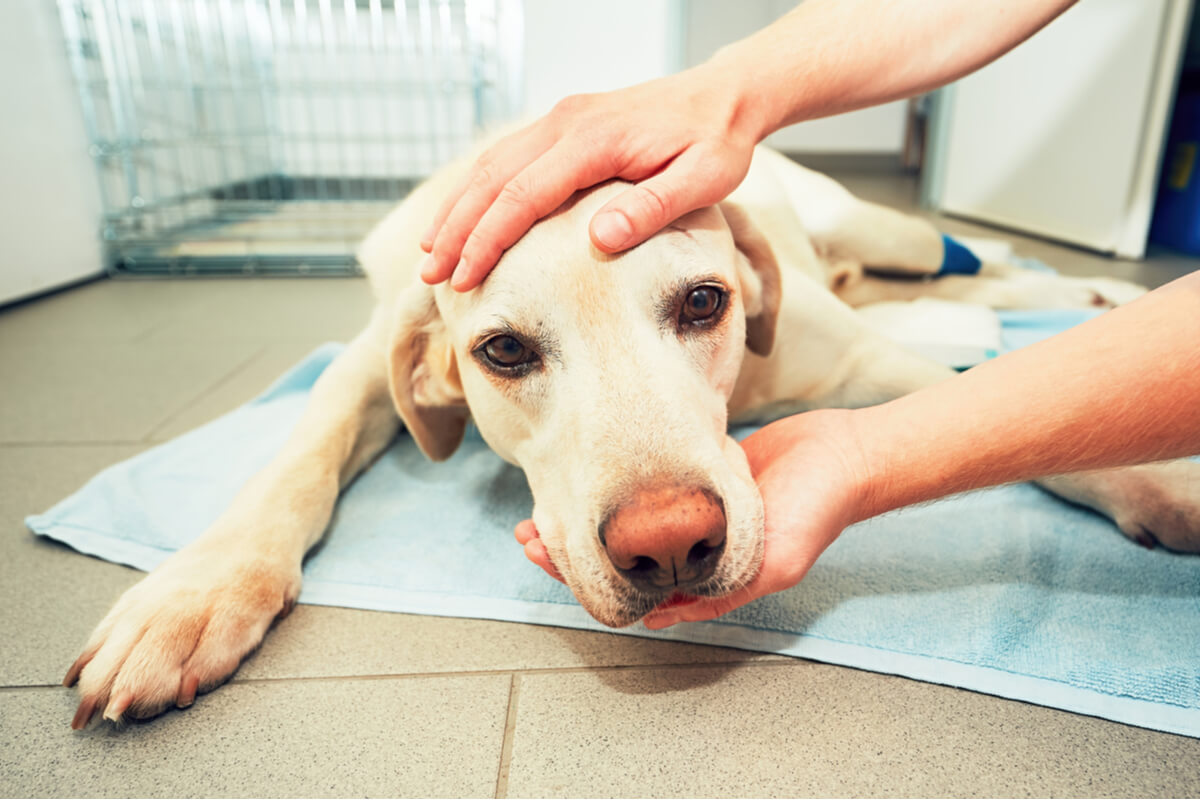Pharyngitis in Dogs: Everything You Need to Know

As with humans, dogs can also develop pharyngitis. Although this ailment has the potential to arrive at any time of the year, cold seasons are the ones that most often trigger it, due to the action of the cold and wind on the dog’s body.
Pharyngitis in veterinary medicine is identified as an inflammatory process, which can be superficial or deep. By affecting the dog’s mucous tissue, palate and tonsils, this condition sometimes makes swallowing impossible, which results in weight loss, weakness, and many other symptoms.
For these reasons, this pathology must be treated immediately by the veterinary professional. This is essential, especially if we take into account that it affects the pharynx, a part of the body that communicates with the nasal and oral cavities. Inflammation of this tissue, if not addressed, can cause the animal to suffocate.
What is pharyngitis in dogs?
Pharyngitis in dogs is defined, thanks to scientific evidence, as an acute inflammation of the tonsils and, therefore, of the pharynx. This condition in dogs is more normal than people often believe and requires urgent veterinary attention. In addition, its most common cause is the presence of bacteria, which can spread to other organs if they are not eliminated.
However, any other affectation that occurs in the pharynx, without having to be bacterial, can trigger pharyngitis. Viral infections, fungal growths, chemical irritants, or allergic processes can also cause this illness.

Causes
Pharyngitis in dogs has several causes, among which we find external ones, which are included in the group of idiopathic acute pharyngitis. According to scientific evidence, these conditions are caused by injuries when swallowing food with bones, or with some other characteristic that makes it difficult for food to pass through the esophagus.
The consumption of very hot or very cold foods has also been identified as a risk factor for developing pharyngitis. Giving the dog food at extreme temperatures is also dangerous, as it can cause inflammation and irritation of the pharynx, leaving it exposed to lacerations – from feeding or swallowing foreign bodies.
As we mentioned, bacterial agents also cause this condition, which can cause pharyngitis to evolve into tonsillitis. According to studies in this regard, the bacteria that affect the appearance of these affectations are the following:
- Escherichia coli
- Staphylococcus aureus
- Streptococcus pyogenes
- Staphylococcus intermedius
- Staphylococcus albus
- Klebsiella spp
- Pasteurella spp
Finally, it has also been shown that there’s a relationship between pharyngitis and systemic diseases, such as distemper and parvovirus. In these cases, the inflammation of the pharynx is caused by a viral infection. After all, the pharyngeal environment is one of the first places that viruses locate when they enter the dog’s body.
Symptoms
Once the dog begins to develop pharyngitis, it will begin to manifest some characteristic symptoms. These are very similar to those that occur in any respiratory disease. The most common are the following:
- A dry constant cough: An excessive accumulation of mucus in the respiratory area, dry tissues, and the presence of foreign bodies produce coughing in mammals, including dogs.
- Frequent sneezing
- Dysphagia – painful swallowing and difficulty in swallowing.
- A loss of appetite
- Sickness
- Hoarse barking
- Tiredness
- Fever
- Excess salivation
- Choking and retching
Additionally, the discomfort experienced by the dog with pharyngitis can make them weak and with little desire to play. When the pathology creates an obstruction in the throat, your dog may manifest stridor (wheezing when inhaling), cyanosis (a blue or gray color in the mouth), and they may even collapse. All of these signs indicate the need for urgent veterinary care.
How to treat pharyngitis in dogs?
When dog pharyngitis is caused by a bacterial agent, veterinarians can usually treat it with 150 milligrams of veterinary amoxicillin trihydrate (antibiotic). This medicine is available in injectable form and is useful when the infection is caused by Streptococcus spp. or Enterococcus spp.
Doxycycline is also frequently used, as it’s a very effective bactericide and acts by blocking protein synthesis. This medicine is usually combined with food to facilitate the pet’s intake, taking advantage of the fact that its effectiveness doesn’t change.
In addition to antibiotic treatment, pharyngitis in dogs is usually also treated with anti-inflammatories and cough suppressants to relieve a dry cough. On the other hand, if the dog is in pain, then the vet will choose an appropriate complementary medication for your dog.
The animal will feel pain when swallowing and, for this reason, its usual food may hinder its recovery. To prevent the condition from getting worse, you can help them by providing them with moist food, canned food, or homemade.
On the other hand, if the condition is of viral origin, there’s usually no possible treatment, other than keeping the canid’s organism constant and waiting for its immune system to stop the infection. If the pharyngitis is due to allergies, professionals sometimes prescribe glucocorticoids, such as prednisone (immunosuppressants).
How can we prevent pharyngitis in dogs?
In order to prevent the appearance of this pathology in your pet, it’s important that you ensure that your dog doesn’t consume foreign elements that can damage the pharynx. Make sure that your food doesn’t cause discomfort or injury, and that it is, as far as possible, at room temperature.
Prevent your dog from getting wet or staying wet for a long time. After bathing, try to dry it as soon as possible, the same as when it gets wet from the rain, especially if it is the cold season or if you live in very cold areas. Check that your dog isn’t getting cold at night and make sure that its bed is warm.
Finally, if you notice any strange symptoms in your pet, the most effective and advisable thing is to visit your vet. Recovery will be much easier if the disease is treated in its early stages.
Home remedies and tips to combat pharyngitis in dogs
Although there are ways to relieve the pain and symptoms of pharyngitis in dogs, you should keep in mind that these aren’t a substitute for the treatment that a professional veterinarian can provide. However, here are a few tips when it comes to the subject:
- To lessen the symptoms, you can try offering a tablespoon of honey to your dog. But beware, avoid this in dogs less than 1 year old.
- You can also provide warm chicken broth without salt or seasonings. As the dog won’t be very hungry, this option can encourage them to eat something.
- Avoid putting a collar on it. It’s better to replace it with a hot water handkerchief, a coat or a cloth that helps it not to be affected by the cold in that area.
- Perform vaporizations. To carry these out, all you have to do is put your dog in the bathroom and turn on the shower with very hot water, so that the dog inhales the steam. This will favor the opening of the airways.
- Avoid inhaling strong substances such as tobacco or smoke.
- Make them drink lots of water to stay hydrated.

Pharyngitis in dogs is a condition that is usually due to a viral or bacterial infection, or a process of hypersensitivity. If your dog shows any of these symptoms, take them to the vet. If the airways are completely impacted, the situation can quickly become serious.
All cited sources were thoroughly reviewed by our team to ensure their quality, reliability, currency, and validity. The bibliography of this article was considered reliable and of academic or scientific accuracy.
- Hutyra, F. Marek, J. (1930) Patología y terapéutica especiales de los animales domésticos. Revista Veterinaria de España, Sección III, 33-49. https://ddd.uab.cat/pub/llibres/1914-1930/60248/patterespanidom_a1914-1930t2f1r1x3.pdf
- Al-Mufti, B. (2014). Isolation of the bacterial causes of tonsillitis in dogs. Iraqi Journal of Veterinary Sciences, 28(1), 27–29. https://doi.org/10.33899/ijvs.2014.89468
- Sylejmani, D., Miftari, I., Hamidi, A., & Robaj, A. (2020). Clinical and bacteriological examinations of dogs with tonsillitis. Bulgarian Journal of Veterinary Medicine, 23(2), 229–236. https://doi.org/10.15547/bjvm.2192
- Sanidad, Ministerio. (2020). Ficha técnica o resumen de las características del producto. Clamoxil. España. https://www.zoetis.es/_locale-assets/spc/clamoxyl-veterinaria-la.pdf
- Ettinger, S. Feldman, E. (2007). Tratado de medicina interna veterinaria enfermedades del perro y el gato. VI ed, V II, EE. UU., 1196-1205. https://www.academia.edu/41826055/Tratado_de_medicina_interna_veterinaria_Enfermedades_del_perro_y_el_gato_vol_2
